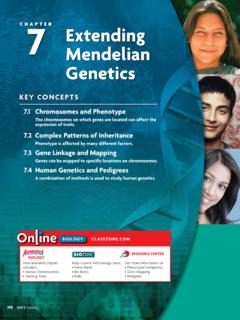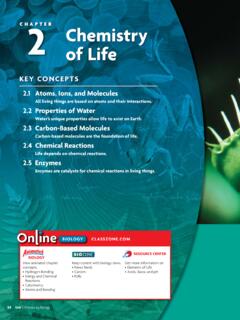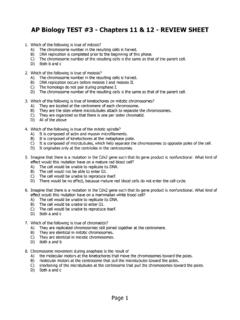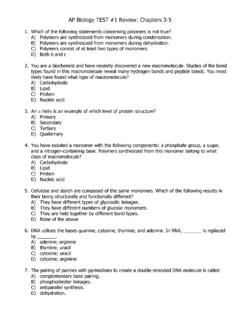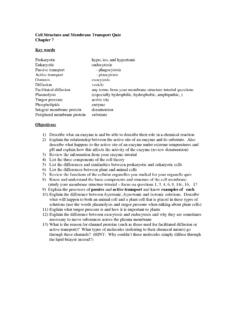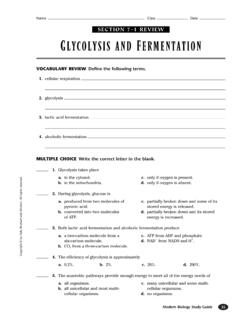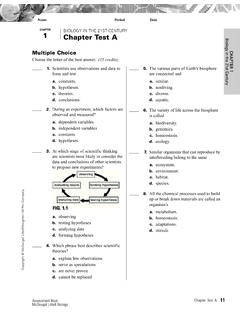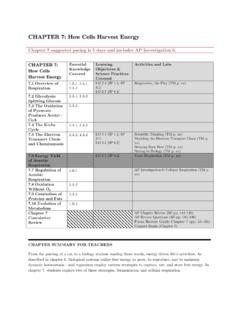Transcription of CHAPTER 8 From DNA to Proteins - Weebly
1 CHAPTER8 From DNA to Proteins Identifying DNA as the Genetic MaterialDNA was identified as the genetic material through a series of experiments. Structure of DNADNA structure is the same in all organisms. DNA ReplicationDNA replication copies the genetic information of a cell. TranscriptionTranscription converts a gene into a single-stranded RNA molecule. TranslationTranslation converts an mRNA message into a polypeptide, or protein . Gene Expression and RegulationGene expression is carefully regulated in both prokaryotic and eukaryotic cells. MutationsMutations are changes in DNA that may or may not affect CONCEPTSBIOLOGYRESOURCE animated CHAPTER concepts. DNA Replication Build a ProteinKeep current with biology news. Featured stories News feeds Strange BiologyGet more information on DNA RNA Mutations224 Unit 3: GeneticsConnectingCONCEPTSWhy is thismouse glowing?
2 This mouse s eerie green glow comes from green fluorescent protein (GFP), which glows under ultraviolet light. Scien-tists put a gene from a glowing jellyfish into a virus that was allowed to infect a mouse egg. The jellyfish gene became part of the mouse s genes. As a result, the mouse cells produce the same protein . Researchers hope to track cancer cells using This computer model of GFP shows the amino acids (purple) in the center of the protein that make the protein glow. The genetic code is universal, which means that a gene from one organism can be correctly translated into a protein in another organism. Although the gene for GFP comes from a jellyfish, GFP has been made in bacteria, yeast, slime mold, plants, fruit flies, zebrafish, and 8: From DNA to Proteins 225a^kZH WVXiZg^Va^kZG WVXiZg^V]ZVi"`^aaZYH WVXiZg^V]ZVi"`^aaZY H WVXiZg^V a^kZ G WVXiZg^VYZVY bdjhZYZVY bdjhZa^kZ bdjhZa^kZ bdjhZFIGURE Griffith s Experiments The S form of the bacterium is deadly; the R form is NOTESMake a table to keep track of the experiments discussed in this section and how they con-tributed to our understanding of DNA.
3 Experiment ResultsGriffth s miceA transferable material changed harmless bacteria into disease-causing DNA as theGenetic MaterialKEY CONCEPT DNA was identified as the genetic material through a series of experiments. MAIN IDEAS Griffith finds a transforming principle. Avery identifies DNA as the transforming principle. Hershey and Chase confirm that DNA is the genetic ,bacteriophage, p. 228 Reviewdeoxyribonucleic acid (DNA), gene, enzyme Connect Some people think a complicated answer is better than a simple one. Ifthey have a head cold, for instance, they may use all sorts of pills, syrups, andsprays, when they simply need rest, water, and warm chicken soup. In the early1900s, most scientists thought DNA s structure was too repetitive for it to be thegenetic material. Proteins , which are more variable in structure, appeared to be abetter candidate.
4 Starting in the 1920s, experiments provided data that did notsupport this idea. By the 1950s, sufficient evidence showed that DNA the samemolecule that codes for GFP in the glowing mouse carries genetic information. MAIN IDEAG riffith finds a transforming principle. In 1928 the British microbiologist Frederick Griffith was investigating twoforms of the bacterium that causes pneumonia. One form is surrounded by acoating made of sugar molecules. Griffith called these bacteria the S formbecause colonies of them look smooth. The second form of bacteria do nothave a smooth coating and are called the R, or rough, form . As you can see inFIGURE , when Griffith injected the two types of bacteria into mice, only the Stype killed the mice. When the S bacteria were killed with heat, the mice wereunaffected. Therefore, only live S bacteria would cause the mice to Unit 3: GeneticsFIGURE Avery s DiscoveriesCHEMICAL ANALYSIS OF TRANSFORMING PRINCIPLE% Nitrogen (N)% Phosphorus (P)Ratio of N to PSample value for : Avery, O.
5 T. et al., The Journal of Experimental Medicine 79 How do the data support the hypothesis that DNA, not protein , is the transforming principle?Oswald AveryConnectingMicrobiology Much of our knowledge of the chemical basis of genetics has come from the study of bacteria. You will learn much more about bacteria in CHAPTER next injected mice with a combination of heat-killed S bacteriaand live R bacteria. To his surprise, the mice died. Even more surprising, hefound live S bacteria in blood samples from the dead mice. Griffith concludedthat some material must have been transferred from the heat-killed S bacteriato the live R bacteria. Whatever that material was, it contained informationthat changed harmless R bacteria into disease-causing S bacteria. Griffith calledthis mystery material the transforming principle. Infer What evidence suggested that there was a transforming principle?
6 MAIN IDEAA very identifies DNA as the transforming exactly is the transforming principle that Griffith discovered? Thatquestion puzzled Oswald Avery and his fellow biologists. They worked formore than ten years to find the answer. Avery s team began by combiningliving R bacteria with an extract made from S bacteria. This procedureallowed them to directly observe the transformation of R bacteria intoS bacteria in a petri s group next developed a process to purifytheir extract. They then performed a series of teststo find out if the transforming principle was DNAor protein . Qualitative tests Standard chemical testsshowed that no protein was present. In contrast,tests revealed that DNA was present. Chemical analysisAs you can see inFIGURE ,the proportions of elements in the extractclosely matched those found in DNA.
7 Proteinscontain almost no phosphorus. Enzyme tests When the team added to theextract enzymes known to break down Proteins ,the extract still transformed the R bacteria tothe S form . Also, transformation occurred whenresearchers added an enzyme that breaks downRNA (another nucleic acid). Transformationfailed to occur only when an enzyme was addedto destroy 1944 Avery and his group presented this and other evidence to supporttheir conclusion that DNA must be the transforming principle, or geneticmaterial. The results created great interest. However, some scientists questionedwhether the genetic material in bacteria was the same as that in other organ-isms. Despite Avery s evidence, some scientists insisted that his extract musthave contained List the key steps in the process that Avery s team used to identify the transforming 8: From DNA to Proteins ASSESSMENTC onnectingCONCEPTSONLINE This micrograph shows the protein coat of a bacteriophage (orange) after it has injected its DNA into an E.
8 Coli bacterium (blue). (colored TEM; magnification 115,000 ) MAIN IDEAH ershey and Chase confirm that DNA is thegenetic evidence for DNA as the genetic material came in 1952 from twoAmerican biologists, Alfred Hershey and Martha Chase. Hershey andChase were studying viruses that infect bacteria. This type of virus, called abacteriophagebacteriophage (bak-TEER-ee-uh-FAYJ), or phage for short, takes over abacterium s genetic machinery and directs it to make more like the ones Hershey and Chase studied are relatively simple littlemore than a DNA molecule surrounded by a protein coat. This two-partstructure of phages offered a perfect opportunity to answer the question, Isthe genetic material made of DNA or protein ? By discovering which part of aphage (DNA or protein ) actually entered a bacterium, as shown inFIGURE ,they could answer this question once and for and Chase thought up a clever procedure that made use of thechemical elements found in protein and DNA.
9 protein contains sulfur but verylittle phosphorus, while DNA contains phosphorus but no sulfur. The re-searchers grew phages in cultures that contained radioactive isotopes of sulfuror phosphorus. Hershey and Chase then used these radioactively taggedphages in two experiments. Experiment 1 In the first experiment, bacteria were infected with phagesthat had radioactive sulfur atoms in their protein molecules. Hershey andChase then used an ordinary kitchen blender to separate the bacteria fromthe parts of the phages that remained outside the bacteria. When theyexamined the bacteria, they found no significant radioactivity. Experiment 2 Next, Hershey and Chase repeated the procedure withphages that had DNA tagged with radioactive phosphorus. This time,radioactivity was clearly present inside the their results, Hershey and Chase concluded that the phages DNAhad entered the bacteria, but the protein had not.
10 Their findings finallyconvinced scientists that the genetic material is DNA and not How did Hershey and Chase build upon Avery s chemical analysis results?REVIEWING MAIN IDEAS 1. What was transformed in Griffith s experiment?2. How did Avery and his group identify the transforming principle?3. Summarize how Hershey and Chase confirmed that DNA is the genetic THINKING4. Summarize Why was the bacterio-bacterio-phagephage an excellent choice for research to determine whether genes are made of DNA or Proteins ?5. Analyze Choose one experiment from this section and explain how the results support the Mendelian Genetics Describe how Mendel s studies relate to the experiments discussed in this Unit 3: GeneticsCHAPTER 8 INVESTIGATIONMATERIALS balance 10 g raw wheat germ laboratory spatula test tube test tube rack 10 mL warm distilled water 2 eyedroppers 4 10-mL graduated cylinders 20 mL detergent solution 3 g meat tenderizer 20 mL salt solution 10 mL cold isopropyl alcohol glass stirring rod PROCESS SKILLS Observing AnalyzingExtracting DNAO swald Avery wrote in a scientific article, At a critical concentration.
